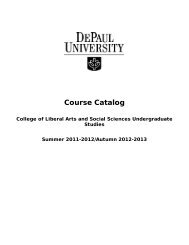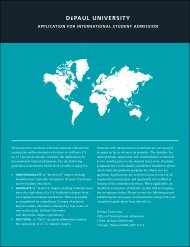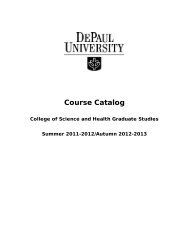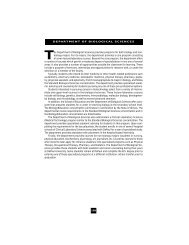Create successful ePaper yourself
Turn your PDF publications into a flip-book with our unique Google optimized e-Paper software.
DEPAUL,<br />
CHICAGO<br />
and the<br />
WORLD<br />
As contemporary metropolises<br />
strive to establish their credentials<br />
as global or “world-class” cities—<br />
by offering financial incentives to induce corporate relocations,<br />
by hosting mega-events such as the Olympic Games,<br />
or simply by inserting the words “international” or “world”<br />
somewhere in the name of their local airport—we sometimes<br />
forget that many of America’s urban centers have long been<br />
international. Consider, for instance, Chicago’s demographic<br />
profile in 1910, when nearly 80 percent of its population had been<br />
born outside the United States, or had at least one parent who had<br />
immigrated to the U.S. Or glance at historian Arnold Lewis’ wonderful<br />
book “An Early Encounter with Tomorrow” (<strong>University</strong> of Illinois<br />
Press, 2001), which documents the reactions of late-19th-century<br />
European visitors to marvels such as the Columbian Exposition,<br />
the Union Stockyards and the skyscraper-sprouting Loop.<br />
We also often forget that depending on your perspective—<br />
a corporate office suite overlooking the booming west Loop, or<br />
along Devon Avenue in West Rogers Park, international Chicago<br />
has distinctly different meanings. In the first instance, Chicago<br />
is an important global metropolis due to its preeminence in<br />
commodities and futures trading, as an advanced business services<br />
node, and still—after so many decades—as a transportation hub.<br />
Devon Avenue, in turn, is a beachhead for aspiring Indian and<br />
Pakistani entrepreneurs, a “community center” for an occupationally<br />
diverse and regionally dispersed South Asian immigrant population<br />
and exotic “night out” for countless Chicagoans who have never<br />
glimpsed the Atlantic or the Pacific, much less the Indian Ocean.<br />
Yet, if all politics is local, perhaps the same can be said of<br />
globalization. And at its local level, metropolitan Chicago and its<br />
many communities have been on a 50-year globalization tear. In<br />
the last half-century Chicago has, in effect, shifted from an international<br />
to a truly global city, especially at the socio-cultural level.<br />
Whether riding the CTA, shopping at IKEA, picking up coffee<br />
at Dunkin’ Donuts or exploring the flavors of a recently arrived<br />
ethnic cuisine, encountering the human dimension of Chicago’s<br />
globalization is unavoidable. Our city was an immigrant capital at<br />
the turn of the last century, and at the dawn of a new millennium<br />
it remains an immigrant capital. But contemporary Chicago is a<br />
global immigrant capital. We are no longer simply talking about<br />
European immigrants, as diverse in language and culture as they<br />
may have been. Now you can name the country—any of the<br />
193 in the world—and some or many of its sons and daughters<br />
live in Chicago. The human face of immigrant Chicago is now<br />
Argentine, Thai, Lebanese and Eritrean.<br />
18 f e a t u r e<br />
by Larry Bennett and John Koval

















